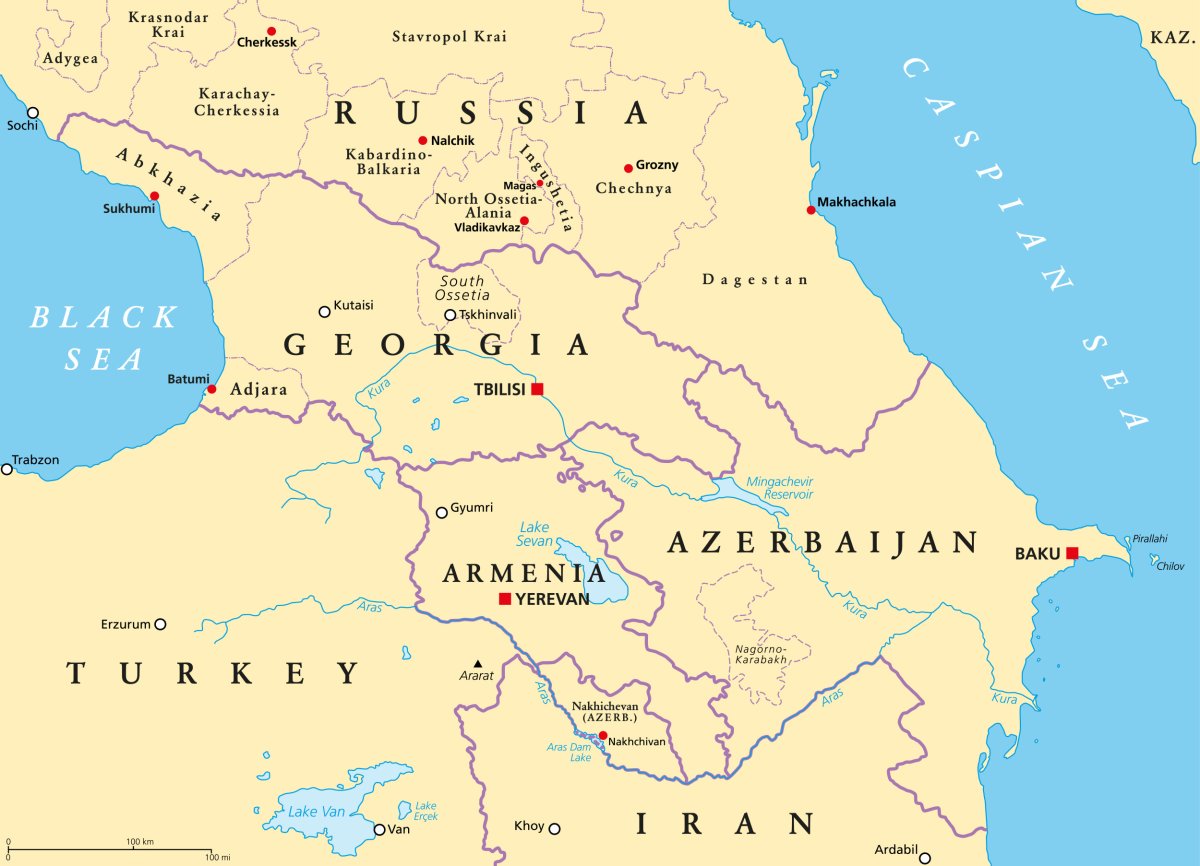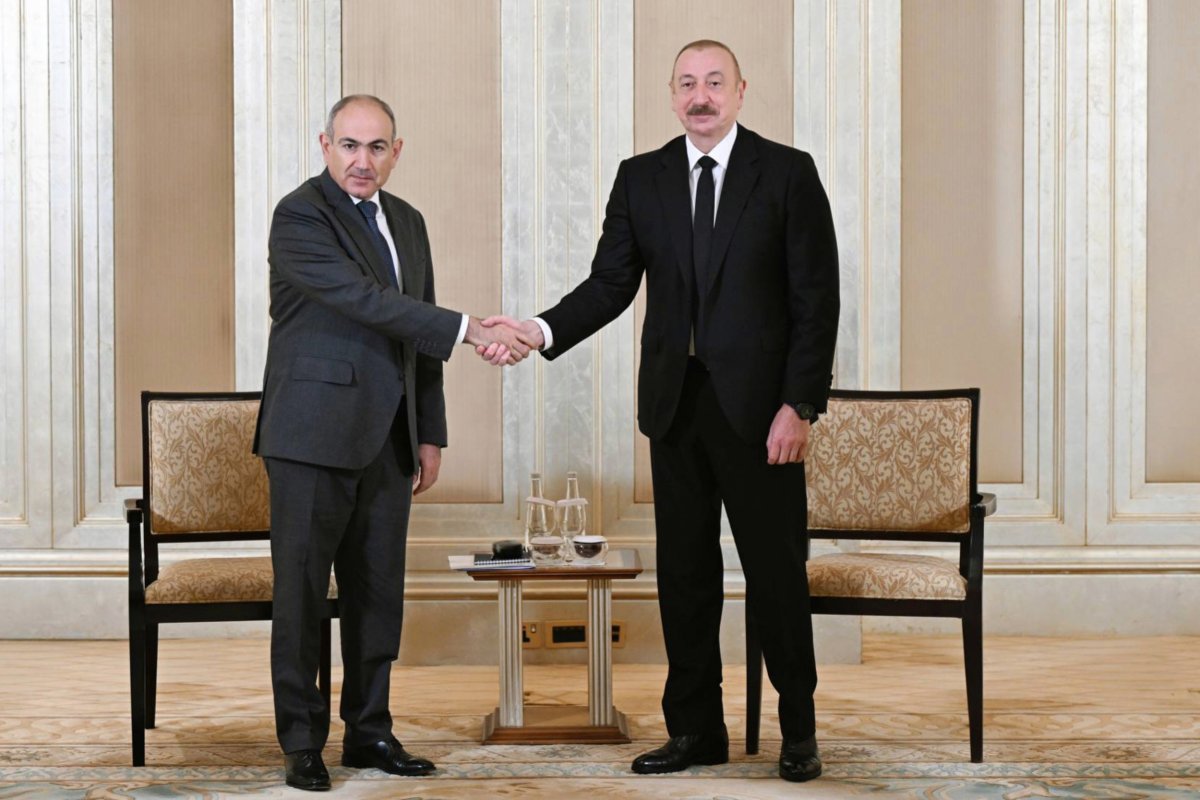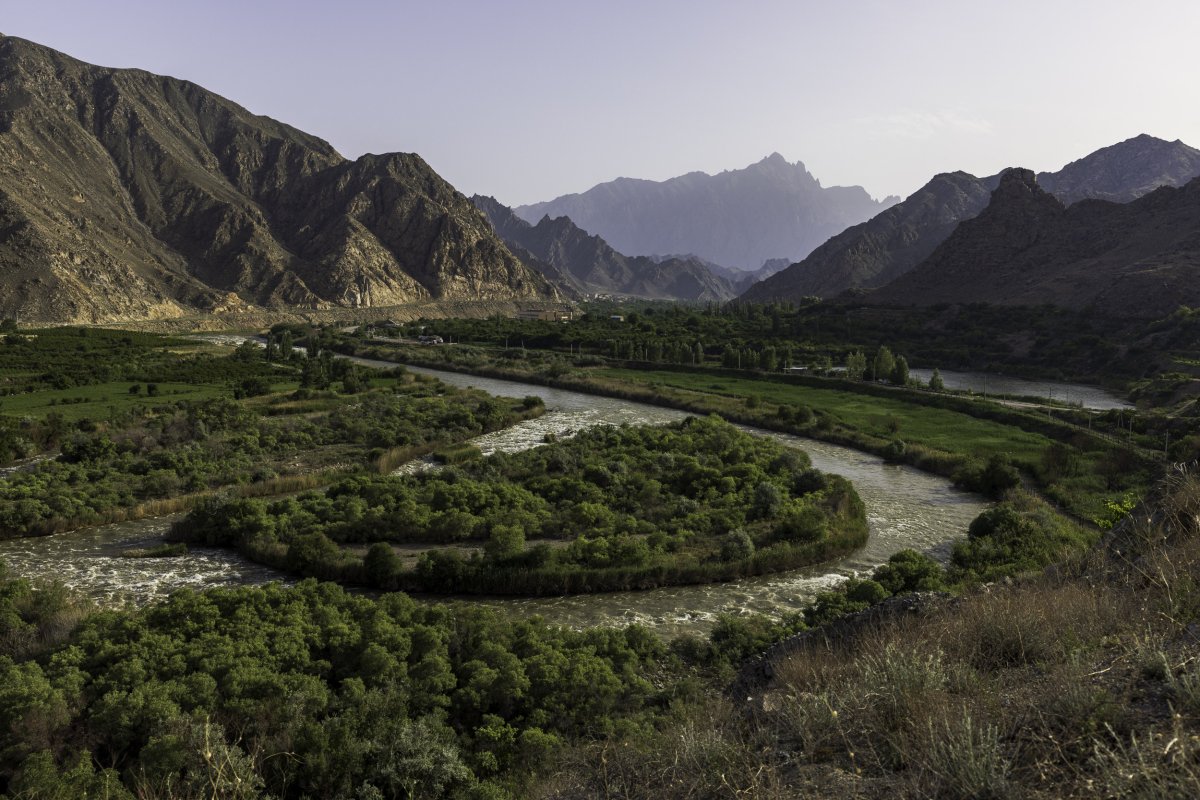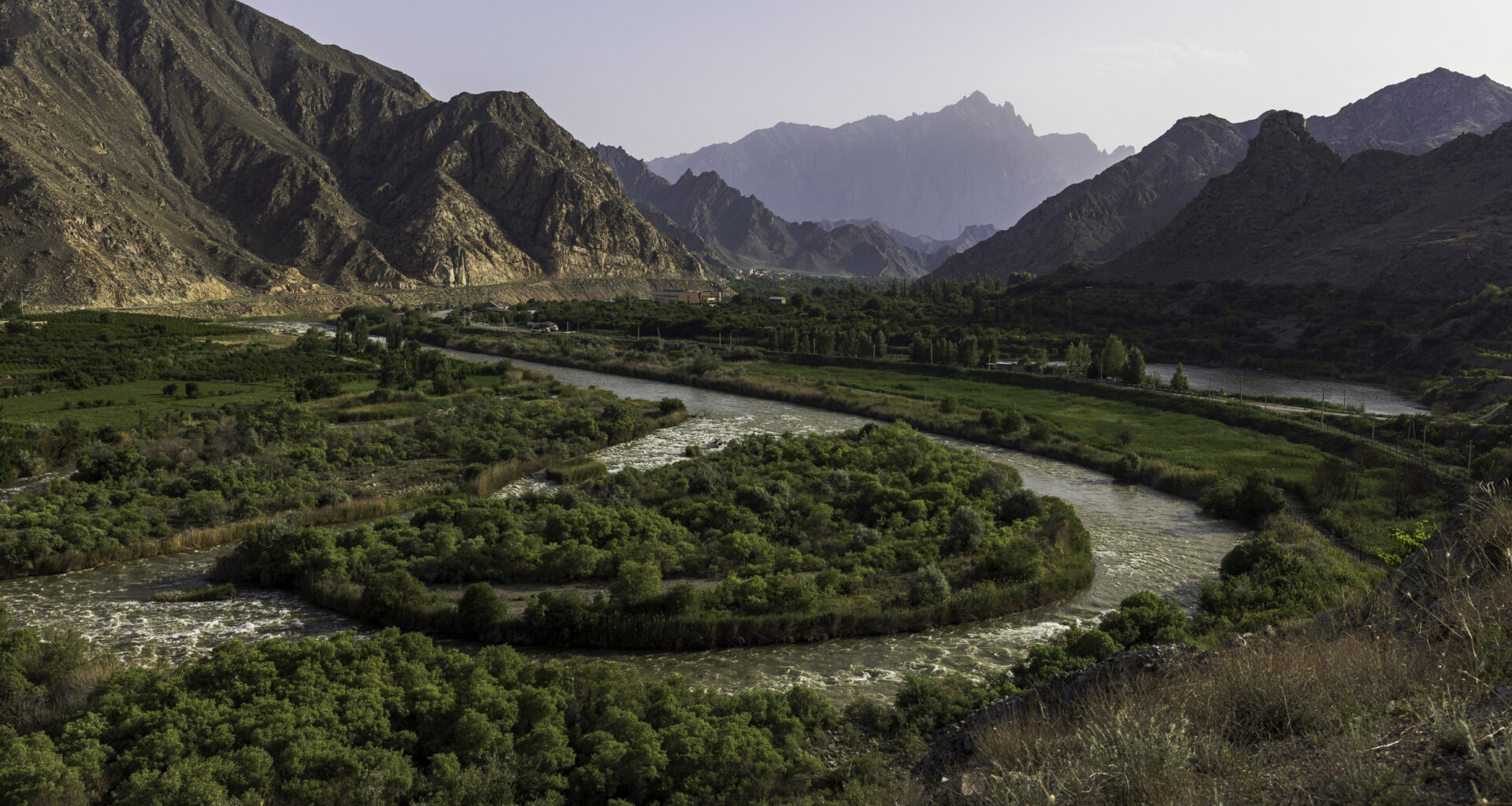As he pushes forward to placate feuds simmering across several regions around the globe, President Donald Trump is set to soon oversee a new peace deal between two bitter rivals in the South Caucasus.
While the details of the anticipated U.S.-backed agreement between Armenia and Azerbaijan have yet to be released as the leaders of both nations meet their U.S. counterpart for a two-day summit starting Thursday, a key aspect of the deal is being referred to as the “Trump Route for International Peace and Prosperity” (TRIPP), or simply, the “Trump Bridge.”
The prospective project would link Azerbaijan’s mainland to its exclave province of Nakhchivan through Armenia via a hotly contested route known in Azerbaijan as the “Zangezur corridor” and in Armenia as “Syunik road.”
The deal also comes on the heels of rapid shifts in the South Caucasus, where in 2023 Azerbaijan launched a swift offensive to seize control of the disputed Nagorno-Karabakh region, dismantling 30 years of Armenia-backed separatist rule. The defeat, which followed staggering losses from Armenia in an earlier war with Azerbaijan in 2020, has left Armenia reconsidering its regional position, including its alliance with Russia and deep-rooted rivalry with Turkey.
For both Trump and the region, it’s an opportunity.
“Trump may be aiming to add this initiative to his Nobel Prize candidacy or simply to confirm his intention to establish peace in the world, but beyond personal motivations, for the region, this is really big and important,” Olesya Vartanyan, an expert in conflicts and security in the South Caucasus, told Newsweek.
“This step forward—even without a final signature on a peace agreement—should increase the chances for stability and no war in the region for a longer period,” she added.

Armenian and Azerbaijani flags can be seen standing just meters apart in the distance on the outskirts of Khnatsakh village in Armenia’s Syunik province on May 16, 2025.
Armenian and Azerbaijani flags can be seen standing just meters apart in the distance on the outskirts of Khnatsakh village in Armenia’s Syunik province on May 16, 2025.
ANTHONY PIZZOFERRATO/Middle East Images/AFP/Getty Images
Peace as Victory
Trump has made little secret of his quest for international recognition over his ongoing peacemaking initiatives.
In this endeavor, he has counted tangible progress in securing agreements on conflicts between Serbia and Kosovo, the Democratic Republic of Congo and Rwanda, Cambodia and Thailand and India and Pakistan, though the extent of the White House’s role in the South Asian crisis that erupted in May remains disputed.
On the two deadliest conflicts raging today, the Russia-Ukraine war and the Israel-Hamas war, Trump has struggled to achieve breakthroughs.
As such, Ali Mammodov, a researcher at George Mason University, pointed out the clear calculus of Trump’s diplomatic intervention in the South Caucasus.
“The idea of U.S. involvement in the ‘Zangezur corridor,’ fits within a broader trend of transactional, interest-based diplomacy that President Trump has favored in other regions,” Mammadov told Newsweek.
“For Trump,” he added, “championing such a project would allow him to present a tangible, infrastructure-based peace dividend, potentially branding it as a personal diplomatic success similar to the Abraham Accords.”
Mammadov also pointed out “several benefits” that both Armenia and Azerbaijan could enjoy from such a deal.
“First, it provides a counterbalance to Russian or Iranian-backed alternatives, allowing both countries to diversify their partnerships,” Mammadov said. “Second, if framed correctly, such a corridor could be seen not just as a regional link, but part of a broader connectivity agenda—tying the South Caucasus into global trade routes via the Middle Corridor.”
“That narrative could help reduce mutual suspicion and make the project more politically palatable domestically,” he added.

A map shows the South Caucasus region, including Armenia and Azerbaijan.
A map shows the South Caucasus region, including Armenia and Azerbaijan.
PeterHermesFurian/Getty
Devils in the Details
Joshua Kucera, senior analyst at the International Crisis Group, also tied the president’s efforts in the South Caucasus to his other diplomatic campaigns, arguing that “it’s clear that the Trump administration is looking for an easy win in peacemaking after Ukraine and Gaza have gone more slowly than he hoped.”
But he noted that questions still linger over the execution of the Armenia-Azerbaijan agreement, including the implementation of a route that has been the center of controversy in the region.
“The most potentially groundbreaking element is the transportation agreement, the TRIPP, and there are a lot of important details that we don’t know yet,” Kucera said.
“In principle, Azerbaijan wants some kind of transportation route that Armenia can’t interfere with between the Azerbaijani mainland and its exclave of Nakhchivan,” he added, “and Armenia also has argued that it wants the same through Nakhchivan, which would be the fastest way to get between northern and southern Armenia.”
Tigran Grigoryan, director of the Regional Center for Democracy and Security in Armenia, echoed how Trump’s success in bringing together Armenian Prime Minister Nikol Pashinyan and Azerbaijani President Ilham Aliyev at the White House “is seen as a quick foreign policy win.”
And he, too, emphasized that the details of the U.S.-backed proposal are at the same time “crucial,” given the demands of both sides.
“Azerbaijan has been insisting on an unimpeded passage for its cargo and passengers to its exclave of Nakhichevan, effectively demanding no Armenian control over the route,” Grigoryan told Newsweek. “Armenia, while open to the idea of reestablishing communications, insists that such a route must operate under its full territorial integrity, sovereignty, and jurisdiction, and follow the principle of reciprocity.”
“That is, if Azerbaijan is allowed to connect to Nakhichevan via Armenian territory under a simplified regime,” he added, “the same rules must apply to Armenia using the Nakhichevan segment of the railway to access its northern regions.”

Azerbaijani President Ilham Aliyev (right) and Armenian Prime Minister Nikol Pashinyan pose for a photo prior to their talks in Abu Dhabi, United Arab Emirates, on July 10, 2025.
Azerbaijani President Ilham Aliyev (right) and Armenian Prime Minister Nikol Pashinyan pose for a photo prior to their talks in Abu Dhabi, United Arab Emirates, on July 10, 2025.
Azerbaijani Presidential Press Office/AP
Competing Interests
The impact of the expected deal, in whatever form it ultimately manifests, is likely to extend beyond the two nations and have ramifications for three powers that border the South Caucasus—Russia, Iran and Turkey.
“Each of these regional powers views the South Caucasus as part of its strategic perimeter, so any U.S. engagement—particularly under a high-profile Trump initiative—will be met with scrutiny,” Mammadov said.
Located on the strategic crossroads of Asia and Europe, Armenia and Azerbaijan have been under the control of the Persian, Ottoman and Russian Empires at various points through history. They gained their independence in 1991 from the Soviet Union, leading to the first major war over the Nagorno-Karabakh region, where ethnic Armenians declared the Artsakh Republic on territory internationally recognized as part of Azerbaijan.
Since that conflict, Armenia and Azerbaijan have both accused one another of ethnic cleansing, while Armenia continues to seek Turkish recognition of the systematic expulsion and killings of Armenians by the Ottoman Empire during World War I, a campaign most nations recognize as a genocide.
Azerbaijan, for its part, has cultivated close relations with Turkey over the past three decades. Turkish drones played a key role in inflicting large-scale losses against Armenia during their 2020 war, subsequent clashes and Azerbaijan’s 2023 offensive that led to the collapse of the Artsakh Republic, along with Armenia suspending its membership in Russia’s Collective Security Treaty Organization (CSTO).
Meanwhile, Moscow and Tehran have another interest in the region, which involves the proposed International North-South Transport Corridor that would establish a sanctions-proof rail route extending from India to Russia. The so-called “Trump Bridge” has the potential to disrupt this plan as reports indicate it may be established close to Iran’s border with Armenia.
Now with the U.S. poised to play a greater role in the troubled region, Kucera noted that “Iran and Russia are of course both wary of any U.S. presence in the region, particularly on security issues, and in this case, the route that we are talking about passes directly along Iran’s border, making any American presence there especially sensitive.”
On the other hand, he said that “Turkey is eager to have better transportation connections eastward through Armenia and Azerbaijan.”

A view from Armenia’s southern border reveals the Arax River, with Iran visible across the water on May 18, 2025.
A view from Armenia’s southern border reveals the Arax River, with Iran visible across the water on May 18, 2025.
ANTHONY PIZZOFERRATO/Middle East Images/AFP/Getty Images
Winners and Losers
Grigoryan also argued that “Turkey is the only one of the three major regional actors likely to welcome the U.S. proposal,” and in fact has already begun building infrastructure to link its eastern city of Kars to Azerbaijan’s Nakhchivan province.
On the other hand, he argued Iran would likely oppose any measure that threats to cut off this link.
“Since the route lies along the Iran-Armenia border,” Grigoryan said. “Tehran sees any weakening of Armenian sovereignty over it as a direct threat to both its northern border and to the North–South transport corridor, which connects Iran to Europe via Armenian territory.”
Also potentially worrying for Iran is the growing relationship between Azerbaijan and Israel, which has prompted Tehran to seek better ties with Baku.
And “for Russia, the issue is even more sensitive,” Grigoryan said, given its waning position in a region it once dominated. “Any success by the U.S. in taking over this initiative would represent a major blow to Russia’s standing in the region.”
Vartanyan argued that “Russia is certainly the loser in this story” as “it had hoped the road would remain under its control.”
“The American move helps Armenia and Azerbaijan achieve more stability and peace—and it further solidifies Russia’s loss of leverage in the South Caucasus, a process that began some time ago and was reinforced by the collapse of Nagorno-Karabakh amid Russia’s invasion of Ukraine,” she said.
“Well,” she added, “this is the price Russia has to pay.”
